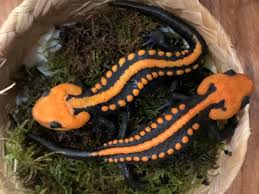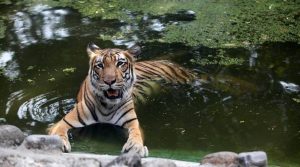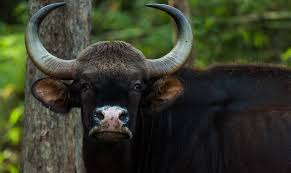Today’s Current Affairs: 19th November 2024 for UPSC IAS exams, State PSC exams, SSC CGL, State SSC, RRB, Railways, Banking Exam & IBPS, etc
Table of Contents
Cao Bang Crocodile newt : New Species Of Crocodile

A new species of crocodile newt, the Cao Bang crocodile newt, has been discovered in Vietnam.
- Cao Bang crocodile newt, or Tylototriton Koliaensis, is a new species of crocodile newt.
- It was found in Vietnam’s mountainous farm.
- It lives in a mountain forest at elevations of 3,300 feet or more where the weather fluctuates from a colder dry season to a warmer rainy season.
- The Cao Bang crocodile newts are medium-sized and are about 5-inches in length.
- It has stout bodies with rough skin, and its scales are like knobs or warts.
- The heads of the crocodile are large, and their limbs are very long and thin.
- It is completely black in colour with a uniform hue of bright orange on marks of fingertips and toes.
- The bottom part of the crocodile has a dark gray stomach and an orange stripe down to the center of the tail.
- The newts breed during the rainy summer in the slow-flowing streams or temporary pools, and they hide under rocks and cavities during the winter.
- crocodile newt is a genus of salamanders found primarily in Asia.
- They are called “crocodile newts” because of their rough, textured skin that resembles the hide of a crocodile.
- Most species are dark brown or black with bright orange or red markings on their head, back, and tail.
Midnight Zone : Study

A team of researchers recently discovered a glowing “mystery mollusk” named Bathydevius Caudactylus within the ocean’s midnight zone.
- The ocean water column is made up of five zones: the sunlight zone (epipelagic), the twilight zone (mesopelagic), the midnight zone (bathypelagic), the abyssal zone (abyssopelagic), and the hadal zone (trenches).
- Sunlight is rapidly absorbed as it travels through water. Red, orange, and yellow are absorbed quickly, leaving water a brilliant blue, but even these wavelengths disappear as light travels deeper.
- By about 1,000 meters (about 3,300 feet) depth, even the faintest light has been extinguished, leaving these deep ocean waters in perpetual darkness.
- The resulting bathypelagic, or midnight, zone extends to about 4,000 meters (about 13,100 feet), which reaches the ocean floor in many places.
- The midnight zone is the single largest habitat on the planet, accounting for 70% of all seawater.
- In addition to the lack of light, the midnight zone is characterized by a steady temperature of around 4° Celsius (39° Fahrenheit).
- Life that exists in this zone must be able to function in cold temperatures and withstand extreme hydrostatic pressure.
- Pressure varies with depth, and in this zone, it ranges from 100 to 400 atmospheres.
- Organisms here have special adaptations including well-developed visual systems, bioluminescence used both to lure prey and attract mates, and well-developed auditory systems that allow them to hear other animals moving nearby.
- Bathydevius Caudactylus is a new species of mollusk discovered within the ocean’s midnight zone.
- Although the apple-size species is classified as a sea slug, the marine animal is unlike any sea slug scientists have seen before.
Nugu Wildlife Sanctuary : Recommendation For Tiger Reserve

The recommendations of the National Tiger Conservation Authority (NTCA) to notify the entire Nugu Wildlife Sanctuary as a core and critical area of Bandipur Tiger Reserve are yet to be implemented.
- Nugu Wildlife Sanctuaryis situated in H.D. Kote taluk of Mysuru district, Karnataka.
- It lies north of Bandipur National Park.
- The sanctuary includes the backwaters of Nugu Dam on its western side and shares borders with Alaganchi State Forest, a part of Bandipur Tiger Reserve on the southwest side.
- Nugu Dam is built across the Nugu River, a tributary of the Cauvery.
- It is also an integral part of the Nilgiri Biosphere Reserve.
- The sanctuary supports a diverse range of fauna, including elephants, tigers, leopards, wild dogs, striped hyenas, sloth bears, gaurs, sambhars, chitals, and four-horned antelopes.
- It is also home to two important riverine wildlife species: the smooth-coated otter and the marsh crocodile, emphasizing its rich biodiversity.
National Epilepsy Day 2024:

National Epilepsy Day is marked every year in India on November 17 to raise awareness about the disease, the struggles associated with it, and the importance of early diagnosis and treatment.
- Epilepsy — also known as a seizure disorder — is a chronic brain disorder where nerve cells don’t signal properly, that causes recurring seizures.
- During a seizure, many neurons send signals at the same time, much faster than normal.
- This surge of excessive electrical activity may cause involuntary movements, sensations, emotions, and/or behaviors.
- The disturbance of normal nerve cell activity may cause a loss of awareness.
- Some people recover immediately after a seizure, while others may take minutes to hours to feel like themselves again.
- Epilepsy has many possible causes, but about half of people living with epilepsy do not know the cause.
- In some cases, epilepsy is clearly linked to genetic factors, developmental brain abnormalities, infection, traumatic brain injury (TBI), stroke, brain tumors, or other identifiable problems.
- Some people may lose awareness during a seizure while others don’t.
- Some people stare blankly for a few seconds during a seizure.
- Others may repeatedly twitch their arms or legs, movements known as convulsions.
- Treatment with medicines or sometimes surgery can control seizures for most people with epilepsy.
- Some people require lifelong treatment. For others, seizures go away.
- Some children with epilepsy may outgrow the condition with age.
Debrigarh Wildlife Sanctuary : Census Conducted

Indian Bisons or Gaurs were counted in the first-ever census of the animals conducted in Debrigarh Wildlife Sanctuary.
- Debrigarh Wildlife Sanctuary is situated in the Bargarh district of Odishanear the Hirakud dam (Mahanadi River).
- It finds a special mention because of noted freedom fighter Veer Surendra Sai. During his rebellion against the British, his base at ‘Barapathara” was located within the sanctuary.
- It was declared a wildlife sanctuary in 1985.
- A huge variety of wild animals reside in the dense forest of the sanctuary, such as Tiger, Sloth Bear, Leopard, Hyena, Spotted Deer, Antelopes, Sambar, Gaur, Nilgai, Bison, Langur Monkeys etc.
- Indian Bisons are one of the largest extant bovines. It is one of the largest species among the wild cattle, reaching a shoulder height of up to 220 cm.
- The gaur is the State Animal of Goa and Bihar.
- Conservation:
- IUCN: vulnerable
- CITES: Appendix I
- The Wild Life Protection Act, 1972: Schedule I
Long-Range Hypersonic Missile:

India’s Defence Research and Development Organisation (DRDO) successfully flight-tested a long-range hypersonic missile off the coast of Odisha.
- The missile can carry various payloads for ranges greater than 1,500 km for the Armed Forces.
- It has been indigenously developed by laboratories of the Dr APJ Abdul Kalam Missile Complex, Hyderabad, along with various other DRDO labs and industry partners.
- The term “Hypersonic” refers to a speed at least five times the speed of sound (also called Mach-5).
- Another key feature of such missiles is manoeuvrability, setting them apart from a ballistic missile that follows a set course or trajectory.
- Hypersonic Cruise Missiles use scramjet engines to sustain hypersonic speeds throughout their flight, flying at lower altitudes and also possessing manoeuvrability.
- The two types of hypersonic weapons systems are Hypersonic Glide Vehicles (HGV) and Hypersonic Cruise Missiles.
- The HGVs are launched from a rocket before gliding to the intended target while HCMs are powered by air-breathing high-speed engines or ‘scramjets’ after acquiring their target.
Tsunami Ready Recognition Programme:

Twenty-four coastal villages in Odisha were recognised by the Intergovernmental Oceanographic Commission of UNESCO as ‘Tsunami Ready’.
- Tsunami Ready Recognition Programme is an international community-based recognition programme developed by Intergovermental Oceanographic Commission (IOC) of UNESCO.
- It aims to build resilient communities through awareness and preparedness strategies that will protect life, livelihoods and property from tsunamis in different regions.
- The main goal of the Programme is to improve coastal community preparedness for tsunamis and to minimize the loss of life, livelihoods and property.
- This is achieved through a collaborative effort to meet a standard level of tsunami preparedness through the fulfilment of a set of established indicators.
- To get this recognition communities must meet all 12 indicators,which cover Assessment, Preparedness, and Response, will be recognized as ‘Tsunami Ready’ by the UNESCO/IOC. The recognition is renewable every four years.
- It is implemented as a voluntary, performance-based community recognition programme that promotes an understanding of the concept of readiness as an active collaboration among national and local warning and emergency management agencies, and government authorities, scientists, community leaders and the public.
Prakash Parv of Guru Nanak Dev Ji:
The President of India greeted citizens on the eve of Prakash Parv of Guru Nanak Dev Ji, urging them to adopt his teachings and promote unity and equality in society.Prakash Parv is celebrated on the birth anniversary of Guru Nanak Dev Ji, the founder of Sikhism and a social reformer.It is celebrated as Prakash Parv because he tried to take people from darkness towards light.
Jeddah Commitments on AMR:
The 4th Global High-Level Ministerial Conference on Antimicrobial Resistance (AMR) concluded in Jeddah, Saudi Arabia, with the adoption of the Jeddah Commitments.Jeddah Commitments laid down practical, actionable and cross-sectoral steps stakeholders to address AMR-related goals by 2030. Its theme was “From Declaration to Implementation – Accelerating Actions Through Multisectoral Partnerships for the Containment of AMR.”
Nepal-Bangladesh Power Transfer via India:
Nepal started exporting electricity to Bangladesh using India’s electricity grid, marking a significant milestone in regional energy cooperation.The power transfer is a result of a tripartite power sales agreement between National Thermal Power Corporation (NTPC) Vidyut Vyapar Nigam, Nepal Electricity Authority (NEA), and Bangladesh Power Development Board (BPDB), signed in October 2023.
Thai Sacbrood Virus:
Research found that pathogen spillover from managed honey bees to wild pollinators poses a serious threat, with shared habitats facilitating disease transmission and endangering pollinator ecosystems.Thai Sacbrood Virus Devastated 90% of Asiatic honeybee colonies in South India (1991–1992) and reemerged in Telangana in 2021. Symptoms: Kills larvae, preventing colony growth and reproduction.
Oriental Pied Hornbill:
In Mayong village, Morigaon district, Assam, a unique community-driven conservation initiative has established an ideal habitat for the oriental pied hornbill, showcasing exemplary efforts in biodiversity conservation. Villagers collectively support the nesting and breeding of oriental pied hornbills, ensuring their safety and well-being.
Maori Group:
New Zealand’s parliament briefly paused as Māori Party MPs performed a haka to protest the Treaty Principles Bill, opposing changes to the 184-year-old Treaty of Waitangi. Indigenous Polynesian people of New Zealand (Aotearoa) who migrated from East Polynesia between 1320-1350.
Panchachuli Mountain Range:
Uttarakhand’s Pithoragarh faces environmental degradation as tourism and emissions accelerate glacier melt in the Panchachuli range.Comprises five snow-capped peaks, forming a part of the Kumaon Himalayas in Uttarakhand, India.Peaks rise from 6,334 m (20,781 ft) to 6,904 m (22,651 ft), with Panchchuli II being the tallest.
Valdecy Urquiza Elected New Secretary General of Interpol:
Brazilian Federal Police Commissioner Valdecy Urquiza has been elected as the new Secretary General of Interpol at the organization’s 92nd General Assembly, held in Glasgow, Scotland, from November 4 to 7, 2024. Urquiza will take over the role from the outgoing Secretary General, Jurgen Stock, on November 7, 2024, marking a significant leadership transition in the world’s largest police organization.
Harbhajan & Sania Mirza Named Dubai Sports Council Ambassadors:
The Dubai Sports Council has appointed four global sports icons as its Sports Ambassadors, including former Indian cricketer Harbhajan Singh and renowned tennis player Sania Mirza. This initiative aims to enhance Dubai’s reputation as a global sports destination and strengthen its sports ecosystem by attracting prestigious international events, nurturing local talent, and promoting sports tourism.
World Day for the Prevention of and Healing from Child Sexual Exploitation, Abuse, and Violence 2024:
World Day for the Prevention of and Healing from Child Sexual Exploitation, Abuse, and Violence Observed on November 18, this day emphasizes raising awareness about the widespread and devastating issue of child sexual abuse and violence. It aims to promote global action to prevent abuse, provide healing, and uphold the rights and dignity of affected children.
SpaceX to Launch India’s Communication Satellite GSAT-20:
India’s heavy communication satellite GSAT-20, weighing 4,700 kg, will be launched from Cape Canaveral, USA, by Elon Musk’s SpaceX on November 19, 2024. The satellite, developed by the Indian Space Research Organisation (ISRO), will provide essential communication services, including internet connectivity to remote areas. This marks a significant milestone in India’s space endeavors, as the satellite is too heavy for India’s own launch vehicle, the LVM-3 “Bahubali.”
Typhoon Man-yi Strikes Northern Philippines:
Super Typhoon Man-yi, locally known as Pepito, has made a second landfall on the Philippines’ main island of Luzon, bringing severe winds, torrential rains, and life-threatening storm surges. The powerful storm has caused widespread damage, particularly in Cantanduanes, where it uprooted trees, destroyed buildings, and disrupted power supplies.
University of Wollongong has launched its India campus in Gujarat’s GIFT City:
Australia’s University of Wollongong (UOW) has officially inaugurated its India campus at Gujarat International Finance Tec-City (GIFT City) in Gandhinagar. The new campus, offering Master’s degrees in Financial Technology and a Graduate Certificate in Financial Technology, marks a strategic entry into the Indian educational landscape, aligning with India’s rapidly growing fintech sector.




